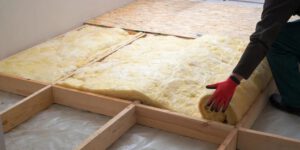Types of Insulation
There are many benefits to using cellulose insulation. It is environmentally friendly and fire-resistant, but some people are sensitive to the fibers. It is stiffer to install than fiberglass, but it is an effective insulator. Read on for more information on the pros and cons of cellulose insulation. You’ll be glad you did once you learn the details. The next time you need to install insulation in your home, remember to choose a type that will keep you warm. Hire a reputable Insulation Companies to do the job for you.
Thermal insulation is found almost exclusively inside the walls of a home, as outside walls are the main areas of the house that are vulnerable to heat loss. It keeps heat from escaping or entering certain rooms and keeps cool air in. There are several different types of thermal insulation, each with a unique R-value. The higher the R-value, the more resistance it provides against heat flow. Look for the R-value on the packaging.
The most important benefit of insulating a building is that it reduces heat transfer. Heat flows from warmer to cooler surfaces, and this flow will not stop until the surfaces are the same temperature. Because of this, insulating materials are important in the food and pharmaceutical industries. For these reasons, it’s important to consider the safety and health risks of each material that is being used in a building. Here’s a look at 5 major types of insulation:
Rigid panels: Another popular type of insulating material is made up of small individual cells. These can be made of foam plastics, rock, or polyisocyanurate. They also come in a variety of materials, including fiberglass, rock, and plastics. The key difference between closed cell and open cell types of insulating materials is in their material composition. The more closed cells, the better. But, they can be more expensive than their counterparts.
Good insulating materials can be blown-in, foam board, or rigid foam panels. They trap small pockets of air in their fibres. These materials can also be made of wood. If you’re unable to install batt insulation, you can use polyurethane-based spray foam solutions for roof tiles and adhesive stips around doors and windows. You can also apply sealants to stop draughts through cracks.
Standard blown-in fiberglass provides an R-value of 3.2 per inch and chemical-free fiberglass loose-fill has an R-value of 4.2. Blown-in insulation is environmentally friendly as it is often made from recycled materials. It is easy to install, cheap, and effective around pipes and ductwork. This type of insulation can be blown in with a vacuum, which makes it easy to reuse. In addition to its cost-efficiency, cellulose is also very effective as a noise-dampening agent.
In addition to airtightness, blown-in insulation is more efficient than rolled batting. It is also less bulky and more flexible, making it easier to fit into small spaces and around oddly shaped objects. In addition to air-tight qualities, blown-in insulation also keeps out moisture, which prevents the growth of mold and mildew. So, when you’re installing new insulation in your home, it’s important to choose the best one for your needs.
While cellulose, fiberglass, and polyurethane are all highly effective, they are not always safe. Fiberglass can be highly flammable, so it is best to choose another type of insulation. Another great alternative is natural materials, such as cork, which has closed cell structure and is also resistant to fire. For those who are concerned about formaldehyde, granulated cork is a safe and effective alternative. This material is also widely used in Europe.
If your home was built before the 1920s, you’re likely to have a solid wall. A solid wall has full-length bricks with half-length bricks in the middle. If you’re unsure, measure the wall from door or window to identify whether it’s a solid or cavity wall. Once you know which type of wall you have, you can choose from external or internal insulation. Once you’ve decided, get to work on insulating your home!
The benefits of installing insulation are many. In addition to saving money on energy bills, insulation helps protect the environment as well. But there are a few disadvantages to DIY installation. For one, it’s not always as cheap as professional installation. If you’re not sure you’re handy enough or have the right tools, you can rent the tools you need to install the insulation yourself. Once you’ve installed the insulation, be sure to keep it clean and in top shape.
